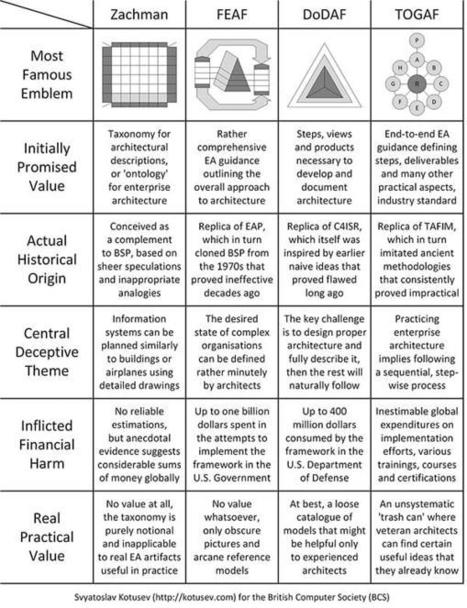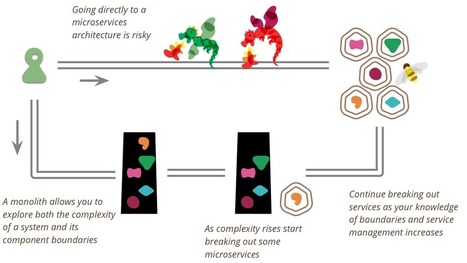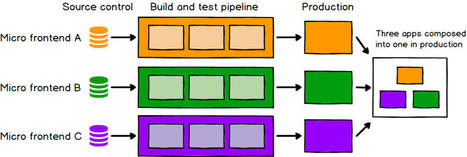 Your new post is loading...
 Your new post is loading...

|
Scooped by
Mickael Ruau
September 21, 2021 5:09 AM
|
In the following article, you can take a look at nine of the best books and sites to learn to become a software architect.

|
Scooped by
Mickael Ruau
September 16, 2021 7:59 AM
|
Note : Cet article propose les grands principes d’une architecture microservices et ce que cela implique dans un SI. Vous y trouverez des basiques, qui sont utiles aux néophytes mais aussi aux plus experts pour qui un rappel fait parfois du bien. Nous passerons en revue les grands types de questions qu’il nous paraît indispensables de poser avant d’adopter les architectures microservices. Il y a 5 ans Martin Fowler en parlait déjà et en 2020, nous avons désormais du recul sur les architectures microservices. Nous savons qu’elles sont pertinentes dans certains contextes où on a besoin de modularité, de performance et / ou d’indépendance des équipes. Nous savons aussi que ce ne sont pas des “silver bullets”. Enfin et surtout nous savons qu’en simplifiant chaque service elles repoussent la complexité dans l’intégration inter services et augmentent ainsi l’entropie des SI. Pour mieux sentir cette complexité, rappelons que dans ce type d’architecture chaque service s’apparente à une application dans l’idéal autonome. Toutes les problématiques d‘intégration inter-applications que vous avez pu croiser par le passé dans votre SI vous les retrouvez au beau milieu de ce type d’architecture autour de chaque microservice. Les architectures microservice augmentent le nombre d’applications qu’il faut maintenir en cohérence, gérer en déploiement et en monitoring. Les besoins en ressources infra IT, les besoins en compétences devops et en architecture d’intégration dans le SI augmentent. La question est donc de savoir si dans votre contexte cela en vaut la peine et si vous êtes en mesure de pouvoir vous l’offrir ?

|
Scooped by
Mickael Ruau
September 16, 2021 7:04 AM
|
What will make microservices the winning paradigm, where its predecessors clearly were not? What makes it tick? As a developer, there’s no doubt that I am rather enthusiastic about microservices, but I was enthusiastic as well (more or less) when people came up with CBD and SOA. I do suppose there are differences. For the first time we seem to have the technology in place to build these type of architectures. All the fancy and complex middleware is gone, and we rely solely on very basic and long-time existing web protocols and technologies. Just compare REST to CORBA. Also we seem to understand deployment much better, due to the fact that we’ve learned how to do continuous integration, unit testing, and even continuous delivery. These differences suggest that we can get it to work this time around. Still, from my historical viewpoint some skepticism is unavoidable. Ten years ago, we also really believed that service oriented architecture would be technologically possible, it would solve all our issues, and we would be able to build stuff faster, reusable and more reliable. So, to be honest, the fact that we believe that the technology is ready, is not much of an argument. Meanwhile the world also got more complex. Over the last year I’ve been involved with a company that is moving away from their mainframe (too expensive) and a number of older Java monoliths (too big, and hard to maintain). Also time-to-market plays an important role. IT need to support introducing a new product in months, if not in weeks. So we decided to be hip and go microservices. Here’s my recap of the good, the bad and the ugly of microservice architectures, looking back on our first year on the road.

|
Scooped by
Mickael Ruau
September 16, 2021 6:57 AM
|
Avant d’entrer dans le vif du sujet, il est nécessaire de préciser deux notions : - On désigne par service un service métier, c’est à dire un groupe de services techniques (REST, SOAP…) qui, ensemble, fournissent une fonctionnalité qui a un sens métier.
- Projet designe un projet de développement informatique sur l’ensemble de son cycle de vie
et pas seulement pendant sa « phase projet » avant une bascule en mode maintenance. 1) Pourquoi les microservices : les problèmes des gros projets L’architecture microservices a été inventée pour résoudre certaines des difficultés causées par les gros projets. Avec le temps, les projets informatiques ont tendance à grossir : on étend petit à petit les fonctionnalités existantes, on en ajoute d’autres, et on supprime rarement les anciennes. En même temps que le code et le projet s’étendent, un certain nombre de douleurs apparaissent

|
Scooped by
Mickael Ruau
September 16, 2021 4:26 AM
|
Un article de Wikipédia, l'encyclopédie libre. L' architecture hexagonale, ou architecture à base de ports et d'adaptateurs, est un patron d'architecture utilisé dans le domaine de la conception des logiciels. Elle vise à créer des systèmes à base de composants d'application qui sont faiblement couplés et qui peuvent être facilement connectés à leur environnement logiciel au moyen de ports et d'adaptateurs.

|
Rescooped by
Mickael Ruau
from Enterprise Architecture
September 20, 2021 3:13 AM
|
For many people, the very notion of enterprise architecture (EA) is closely associated with EA frameworks, if not entirely synonymous to them, writes Svyatoslav Kotusev, Enterprise Architecture researcher.
Via Emeric Nectoux

|
Scooped by
Mickael Ruau
September 10, 2021 7:53 AM
|
The role and structure of an enterprise architecture in a DevOps environment comes down to developing a common culture and connnecting processes and tools.

|
Scooped by
Mickael Ruau
August 24, 2021 8:44 AM
|
Le DAT est un document formidable, il permet de définir la vision technique de l'application et de répondre aux questions suivantes: Quel type d'architecture? Quelle base de données, et quel type d'utilisation ? Quel Framework d'accès aux données ? Quelle technologie d'interface utilisateur ? ...

|
Scooped by
Mickael Ruau
July 31, 2021 7:51 AM
|
How Amazon's service oriented architecture ensures they are building unrivalled capabilities

|
Scooped by
Mickael Ruau
July 14, 2021 1:54 AM
|
Software architecture diagrams can be a very useful communication tool, but many teams have scaled back on the creation of diagrams, and when diagrams are created, they are often confusing and unclear. The C4 model consists of a hierarchical set of software architecture diagrams for context, containers, components, and code.

|
Scooped by
Mickael Ruau
July 12, 2021 1:57 AM
|
One of the most useful design principles that I've found and followed is that of keeping a good separation between the presentation aspects of a program (the user interface) and the rest of the functionality. Over the years where I've seen this done, I've seen plenty of benefits: - Presentation logic and domain logic are easier to understand when separate.
- You can support multiple presentations on the same base program without duplicating code.
- User interfaces are hard to test, separation keeps more logic in more testable places.
- You can easily add a programmatic API for scripting or exposed as services (I actually see these as alternative presentations).
- Presentation code requires different skills and knowledge to domain code.

|
Scooped by
Mickael Ruau
July 12, 2021 1:22 AM
|
There are several ways to split up the logic of the presentation.

|
Scooped by
Mickael Ruau
July 8, 2021 7:27 AM
|
I personally feel that micro (service) architecture has officially made it’s way over to front end architecture. This means that it is now important for a UI Engineer, to be aware of wha
|

|
Scooped by
Mickael Ruau
September 21, 2021 5:08 AM
|
Découvrez le modèle architectural BLoC qui améliorera la maintenabilité à long terme de vos projets logiciels.

|
Scooped by
Mickael Ruau
September 16, 2021 7:13 AM
|
In the past year (2019) I spent a lot of time talking, writing, podcasting and just chatting with people about micro-frontends.

|
Scooped by
Mickael Ruau
September 16, 2021 7:01 AM
|
Going directly to a microservices architecture is risky, so consider building a monolithic system first. Split to microservices when, and if, you need it.

|
Scooped by
Mickael Ruau
September 16, 2021 5:22 AM
|
L' architecture logicielle décrit d'une manière symbolique et schématique les différents éléments d'un ou de plusieurs systèmes informatiques, leurs interrelations et leurs interactions. Contrairement aux spécifications produites par l' analyse fonctionnelle, le modèle d'architecture, produit lors de la phase de conception, ne décrit pas ce que doit réaliser un système informatique mais plutôt comment il doit être conçu de manière à répondre aux spécifications.

|
Scooped by
Mickael Ruau
September 15, 2021 7:40 AM
|
Microservice Architecture, Database per Microservice, Event Sourcing, CQRS, Saga, BFF, API Gateway, Strangler, Circuit Breaker, Externalize Configuration, Consumer-Driven Contract Testing

|
Scooped by
Mickael Ruau
September 10, 2021 8:17 AM
|
This document is The Open Group Open Agile Architecture™ standard, also known as The Open Group O-AA™ standard. It has been developed and approved by The Open Group. This document follows a modular structure and is organized in the following parts: Examples and case studies are provided as illustrations to foster understanding of the standard. Examples and case studies are not a normative part of the standard and therefore do not include requirements. The target audience for this document includes: -
Agilists who need to understand the importance of architecture when shifting toward an Agile at scale model, and who want to learn architecture skills -
Enterprise Architects, solution architects, security architects, and software architects who want to stay relevant in an Agile at scale world and who need to learn new architecture skills for the digital age -
Business managers and executives who need to learn the importance of the architecture discipline, and who need to influence architecture decisions

|
Scooped by
Mickael Ruau
August 30, 2021 1:12 AM
|
The panelists discuss some of the most fun and least fun moments coding, how functional programming practices have helped, and how productivity can be unleashed at a team-of-teams scale.

|
Scooped by
Mickael Ruau
August 17, 2021 5:54 AM
|
Use the guidance in this ebook about building microservices to learn what a microservice is, and why you might need a microservices architecture to make your applications faster, more flexible, and more stable.

|
Scooped by
Mickael Ruau
July 21, 2021 10:05 AM
|
With a bucket of Legos, you can tell any story. You can build an airplane or a dragon or a pirate ship—it’s whatever you can imagine.
Christopher Miller One of the hallmarks of any digital transformation is increased speed and agility. Decisions need to be made more quickly using data and algorithms. Digital services need to be created rapidly to capture new revenue streams and increase customer experience. You might have heard your CTO or Chief Architect (or AWS) talk excitedly about a new software architecture that is going to save your business, make it more agile, innovative, and solve world hunger called microservices. Much has been written about the technical aspects of microservices architecture, but the non-technical aspects (business, organization, etc.) of microservices I find are not covered with the same frequency or energy. But before I cover the non-technical aspects of microservices, I think it’s worth trying to explain it in layman’s terms and the connection to business value.

|
Scooped by
Mickael Ruau
July 13, 2021 10:21 AM
|
L'infrastructure AWS correctement architecturée fournit des conseils afin d'aider les développeurs à créer et à déployer leurs applications plus rapidement, à réduire les risques et à prendre des décisions éclairées, conformément aux bonnes pratiques d'AWS.

|
Scooped by
Mickael Ruau
July 12, 2021 1:45 AM
|
How to split up your large, complex, frontend codebases into simple, composable, independently deliverable apps.

|
Scooped by
Mickael Ruau
July 9, 2021 12:55 PM
|
Software design is an exercise in human relationships.
|
 Your new post is loading...
Your new post is loading...
 Your new post is loading...
Your new post is loading...

































